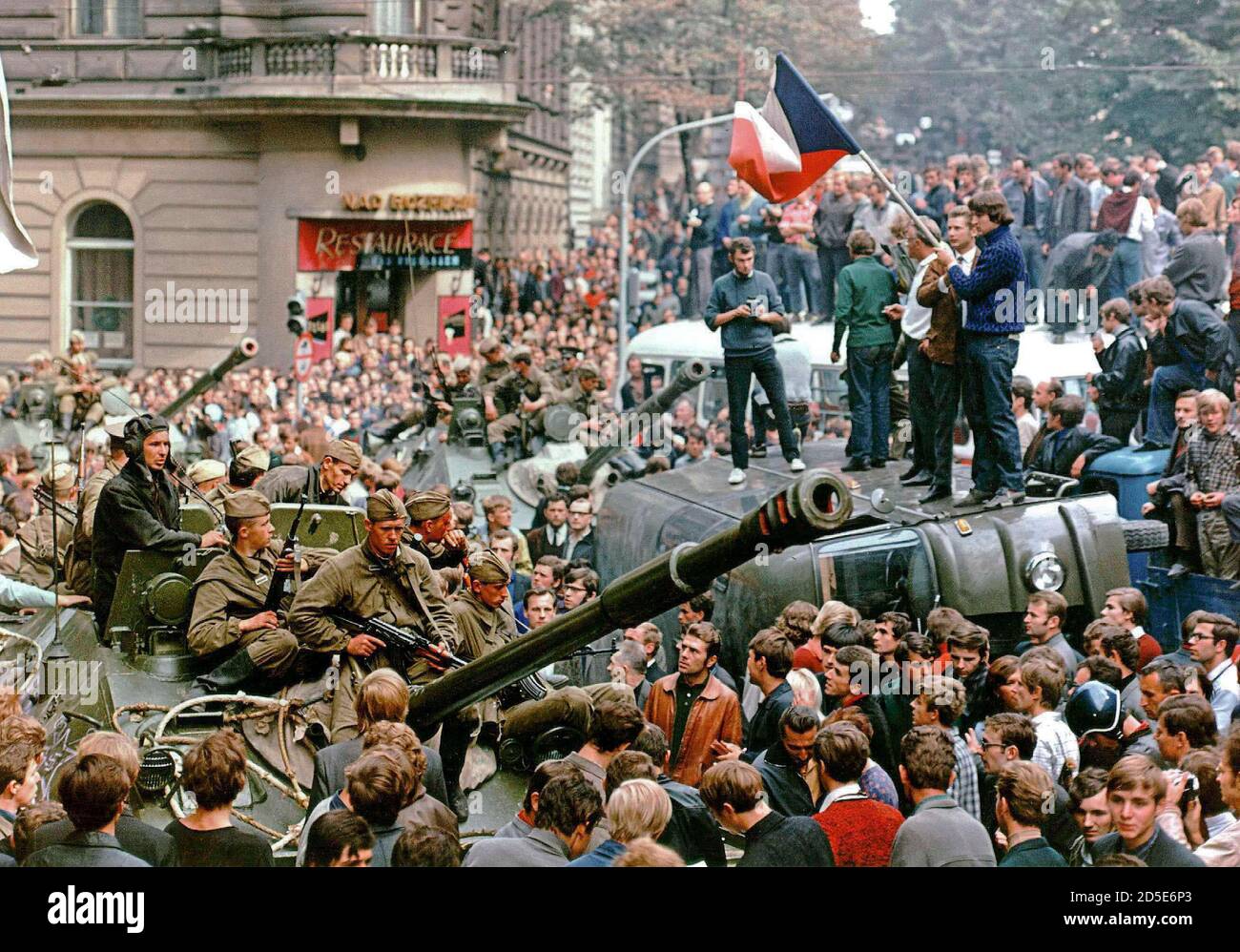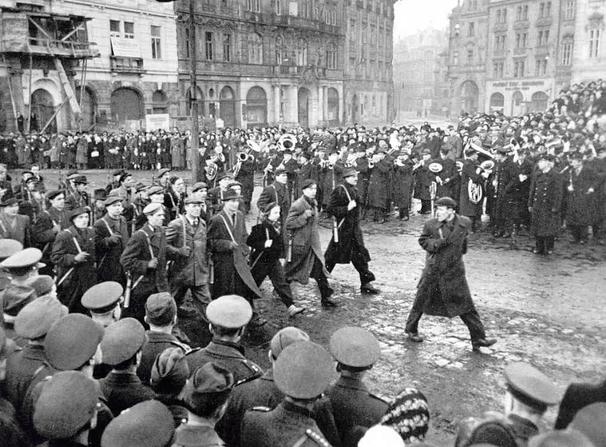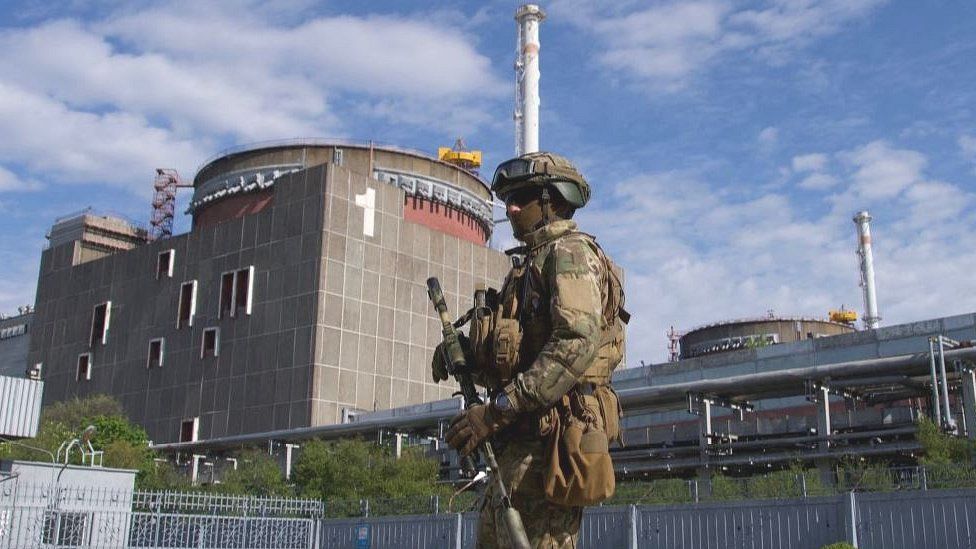
Crowd of Czech protesters surround Soviet tanks during 1968 invasion.
When a Country Is Invaded,
Civilian-Based Defense Can Work
John MacDougall / Waging Nonviolence
(December 24, 2024) —If smart and widespread preparations to use civilian-based defense are made before invasions happen, history shows it can be more effective than military force.
When a country is invaded — like Ukraine by Russia in 2022 — can nonviolent defense work? For invading armies and police to achieve their goals, they must always depend to some extent on the local population. Then if that population resists nonviolently in large numbers and using smart strategies, the occupiers may be nable to carry out their plans.
This type of resistance — often called civilian-based defense, or CBD — harnesses the energies and resources of nonviolent persuasion and non-cooperation, and can be much more effective than military force.
This isn’t just an academic topic. After the Russian invasion in 2022, many progressives backed Ukraine defending itself militarily, even though most of these progressives strongly support nonviolent action on issues like climate and racial justice.
Of course, one reason for leftists’ support for Ukraine’s military self-defense is their revulsion at Putin’s actions and ideology. But another important reason is the widespread belief that there is no other way for Ukrainians to defend themselves.
However, CBD has been very effective in the past, on many occasions — a fact that is little known, even to politically aware people. Plus, it has a good chance of succeeding in today’s world, especially if activists and others make smart and widespread preparations to use CBD before invasions happen. It can therefore undermine the argument that military self-defense is the only alternative to surrender.

Thwarting the Nazis
Every time CBD has been used, citizens have seized the initiative, and refused to comply with occupying armies and officials.
After Nazi Germany invaded Norway in World War II, local people used CBD in many ways. The most significant example happened between February and November 1942, when the Nazis tried to bring the whole society under fascist control, starting with school teachers who were intended to be the first sector where a “corporative state” was created.
In such a state, the Nazis sought to control the whole population through dictatorial institutions. However, the Nazi occupiers failed: schools were never used for fascist propaganda, a fascist teachers union never came into being, and people kept up their commitment to nonviolent resistance.
Almost all teachers refused to join the fascist union, even when schools were ordered reopened after the regime closed them for a month. These acts made it much harder for Nazi officials to implant their ideology in the minds of teachers, students, families and neighbors. In addition, when schools were shut down, teachers held classes in private homes.
Tens of thousands of parents and teachers sent written protests to the authorities, and news of parents’ resistance reached almost every home in the country — making it impossible for the Nazis to arrest every Norwegian.
About a thousand teachers were arrested, but while they were in jail, they still received the equivalent of their salaries from “somewhere.” This reduced the suffering that jail inflicted on teachers’ families, and kept up their morale. Almost 500 of those jailed were sent to concentration camps in the far North, where conditions were grim, but very few of them agreed to teach Nazi propaganda. These teachers paid a heavy price for their resistance, and teachers’ unity and resilience must have infuriated the authorities.
As the resistance continued, Gene Sharp, an influential scholar of nonviolent action, wrote that, “if the Quisling [Nazi puppet] regime took harsher measures against the teachers, the fascists risked permanent antagonism towards the regime.”
In the end, Quisling was ordered by Hitler to abandon his effort to create a corporative state, whereby the Nazis sought to control the whole population through dictatorial institutions. A few of the jailed teachers were shot by the Nazis for acts of sabotage, but it appears that otherwise, nobody was killed for acts of CBD.
Various aspects of the broader context made it easier for Norwegians to use CBD effectively, and to initiate important acts of resistance. In 1935, after decades of union organizing in Norway — plus the growth of a significant fascist movement in the country — both labor leaders and top employers realized that a social compromise was needed. So they all signed an agreement that guaranteed the right to strike, but also allowed employers to continue to own and guide their firms.
Also in the 1930s, major socialistic reforms were enacted in areas like public health, housing and pensions. Nonviolence was part of the Labor Party’s manifesto until 1949. Developments like these made it easier for the vast majority of Norwegians to unite in the face of the occupiers and participate in nonviolent action.

Defending Prague Spring
Another important historical case of CBD took place in Czechoslovakia in 1968-69. For the first eight months of 1968 the country experienced what was called the “Prague Spring.” Press censorship was ended, and the media were mobilized to support reforms. Many ordinary people supported this, and the Communist Party under General Secretary Alexander Dubcek became truly popular. Social Democrats began to form a separate political party. Communist and government leaders said they were still committed to socialism, but anti-Soviet articles were published.
In August 1968, the USSR and allied countries tried to stop the Prague Spring, sending 500,000 troops into Czechoslovakia. The invaders’ aims were successfully thwarted by innumerable spontaneous acts of CBD, with the vast majority of protests being nonviolent.
Within hours of the invasion, Czechoslovak leaders ordered all troops to stay in their barracks. They told everyone to remain calm, and to respond to the invaders with “passive resistance.” The president refused to sign a document presented to him by Stalinist Communists. A special anti-occupation Party Congress was successfully convened, with its location kept completely secret.
The government and others distributed thousands of anti-Soviet leaflets and newspapers. Local police often collaborated with resisters, and none provided any assistance to occupying forces. The Czechoslovak secret police, siding with the resisters, got hold of lists of people who were to be arrested, and leaked this information to radio stations which immediately published details, preventing the arrests from happening.
The occupiers were unable to remove the leaders of the resistance or spread fear among the population. A few days after the invasion, several top Czechoslovak leaders were summoned to Moscow. When they arrived they weren’t arrested, but instead negotiated with Soviet leaders.
The Czechoslovak leaders made some unnecessary concessions, such as allowing Soviet troops to stay in their country. But at least the Czechoslovak leaders kept their jobs, and for eight more months there continued to be street demonstrations and student sit-ins.
In addition, during this period, “anti-Soviet sentiments and the desire for freedom were widely articulated,” according to a New York Times reporter. All of the acts of nonviolence in 1968-69 made it impossible for the occupying forces to take control of the organs of government and mass communications, or to implement the repressive policies sought by the USSR.
Citizens performed a great variety of nonviolent acts. When the lists of planned arrestees were published, people immediately removed and painted over street signs, making it much harder for occupiers to find people to arrest. There were nonviolent blockades of invading tanks and Soviet communications equipment, including in some rural areas. Farmers and shopkeepers refused to provide supplies to Soviet and allied troops.

As a result, many Soviet soldiers were reported as experiencing visible guilt and sorrow, and they had to be rotated out of Czechoslovakia after only a few days in the country. Because of this, the logistical, financial and morale costs to the occupiers was far higher than anticipated. Insurgent radio stations provided the public with essential information, which helped maintain morale and build trust in resisters’ alternative media. Humor and satire also played a role: for example, graffiti was painted on walls saying “Ivan, go home. Igor is in bed with Natasha.”
In many ways, the broader context made widespread use of CBD more likely and more effective. There are important ethnic and other divisions within the country, in particular between the Czech and Slovak regions. However, in 1968 earning power was about the same in both regions.
In addition, thanks to policies implemented under Communist rule after 1948, blue- and white-collar workers’ earnings were about the same by 1968, and rural housing had greatly improved. Therefore, from the start of the Soviet invasion, it was easier for people to collaborate in CBD across regions, between social classes, and between cities and the countryside. Czechoslovakia didn’t have a strong tradition of nonviolent action, but throughout the 20th century, many prominent Czech writers and filmmakers were critical of social injustice and established authorities.
The “spring” essentially continued for eight months until April 1969, when a new repressive Communist Party secretary was installed. Only 70 people were killed in nonviolent actions through April.
In these and many other historical cases of CBD, all the nonviolent actions were spontaneous. They would have been even more effective if there had been conscious preparation for using CBD.

Contemporary Initiatives
In the late 20th century — and especially after the end of the Cold War — some government officials and military planners did analyze CBD and spoke publicly about it, as one way to defend their countries. This happened in Estonia, Finland, Latvia, Lithuania, Norway, Sweden and the former Yugoslavia. Gene Sharp tried hard to get governments to commit to CBD, without much success.
As Jorgen Johansen and Brian Martin point out in their book “Social Defense,” we can’t expect governments to take the lead in such planning, since “a population empowered to use nonviolent action can turn those skills against the government itself.” In addition, as Richard Sandbrook has argued, major expansion of government-sponsored CBD poses a serious threat to the interests of military-industrial-intellectual complexes. So instead, the main initiative in making preventive preparations for CBD must come from social movement organizations.
Since the use of CBD in Czechoslovakia in 1968-69, there have been much analysis of CBD. However, the only large-scale use of it in recent decades has been in Ukraine. Civil resistance scholar Daniel Petz wrote that civil society networks built during the Euromaidan revolution in 2013-14 became active after Russia invaded in February 2022.
The situation is complex and constantly changing. Between February and June 2022 there were street protests and non-cooperation with Russian invaders. “[M]ost of the mobilization seems to have been spontaneous, based on informal networks and trusting relationships,” Petz explained. As the war dragged on, CBD became much harder because of massive destruction and severe repression in the Eastern regions under Russian control.
However various groups continued to secretly and creatively resist the occupiers, making brilliant use of social media. For example, counterfeit 50-ruble notes were distributed, where the Bank of Russia’s logo was replaced by “Bank of Angry Mavka” — Mavka being a mythical Ukrainian figure who lures men to their deaths.

Another important initiative in Ukraine is the Zaporizhzhia Protection Project, or ZPP, launched under the auspices of World BEYOND War. This was an effort to have an international unarmed team live and work in the region next to the massive six-reactor nuclear energy plant on the front line of the fighting, which is currently under Russian control. The goal was to prevent the catastrophic release of radiation on the scale of the Chernobyl disaster, through an intentional or accidental mishap at the plant.
ZPP sent two international teams of four people, in April and September 2023. The first team spent five days in the region, the second team seven days. However, ZPP facilitator John Reuwer — who was part of both teams that went in 2023 — said that as of September 2024, they have been “unable to find sufficient support from civil society on the Ukrainian side, and permission from the Russians to visit the occupied area around the plant.”
Acknowledging the small victories of CBD is difficult in the midst of war, but is still important.
“Even the amazing people of Enohodar, who held off the Russian army for three and a half days during the first week of the invasion, downplayed what they had done because they ‘lost the city,’” Reuwer explained. “Only after reflecting on how that compared to the National Guard defense of the city, which lasted 3 hours, and the fact that many cities had been lost by the armed forces, did they begin to smile and animate at the memory of what they had done.”
In recent decades, almost no work has been done by movement groups, to educate the public about CBD, to train activists, to craft strategies, or to build organizational capacity and broad coalitions. But it’s clear from history and from contemporary actions that CBD can work, even in the face of very repressive invaders and other extreme difficulties. What is needed for CBD to achieve its full potential is social movement organizations making smart and sustained advance preparations before the next invasion.
Many thanks to George Lakey and Eli McCarthy for invaluable feedback, and to Tehya Gerbino for research assistance.